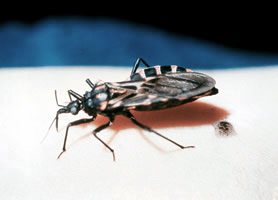By NewsDesk @infectiousdiseasenews
Entomologists from the Nebraska Department of Agriculture and University of Nebraska-Lincoln Department of Entomology identified a species of kissing bug for the first time in Nebraska last summer, the state department of health reports.

Image/CDC
“Kissing bug” is the common name for a group of bugs called triatomines. These are blood-sucking insects that are found across the Southern United States, Mexico, Central, and South America especially during the summer months. The species recently detected in Nebraska was identified as Triatoma sanguisuga or the Eastern blood-sucking conenose. This species has been found as far north as Pennsylvania and as far west as Texas.
The main risk associated with kissing bugs is the presence of a parasite called Trypanosoma cruzi (T. cruzi for short) that lives in the bug’s intestines and is shed in feces. This parasite can cause Chagas disease in the people and animals it infects. Although infections from this parasite are not common, approximately 25% of people that are infected develop serious chronic disease, so early diagnosis is important. Importantly, infections from the Eastern blood-sucking conenose are even rarer and the risk of infection in Nebraska is considered to be very low. However, some of the collected kissing bugs were tested for the presence of T. cruzi with several testing positive for the parasite. This is the first recorded detection of this parasite in Nebraska.
Anyone who has seen kissing bugs in their home or who thinks they may have been bitten by one should talk to their doctor about getting tested for Chagas disease.
- Florida reports 4th Eastern Equine Encephalitis case in a horse in Leon County
- RSV activity up in the US south
- Freshpet dog food sold at Publix recalled over Salmonella risk
- Typhoid outbreak kills 17 in Kwango, DRC
- H5N6 avian influenza case reported in Chengdu, Sichuan Province
- University of Florida study looks at new ways to treat antibiotic-resistant bacteria like MRSA
- Nevada: First case of Hantavirus Pulmonary Syndrome reported in Douglas County
- Michigan reports first hantavirus case



One thought on “Kissing bug detected in Nebraska for the first time”